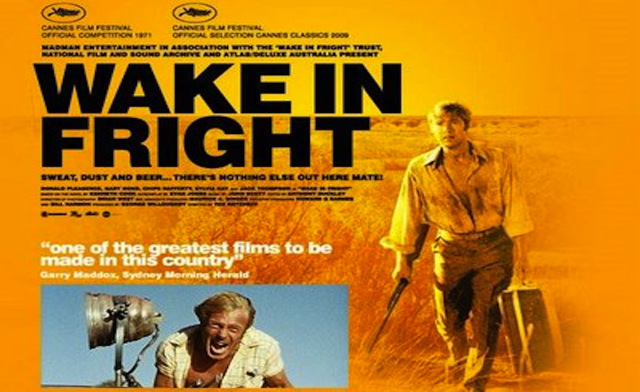
Wake In Fright Review
No country does that feeling of the strange and unhomely like Australian cinema. Think of Peter Weir’s Picnic at Hanging Rock (1975) or The Last Wave (1978) and the unhappily married couple on a camping trip in Long Weekend (also 1978) with nature taking over and causing the couple to go mad. In all these films there is a pervading sense that nature was taking over that man was in a very uncomfortable relationship with it; an unease that seems to drive the protagonists insane in some of the most terrifying examples of cinema. Because of this these films are normally classified under the genre of horror. And the restored re-release of Wake in Fright is no different in this sense and more than this is a real forgotten revelation. More of this later.
The story in itself is very basic. It revolves around a teacher called John Grant on transit to Sydney to meet up with his girlfriend stops in a deadwood outback town called Bundunyabba. When he arrives in this dry hole he finds all the locals cheerful and can’t understand his disdain for the town: “What, ya don’t like the Yabba?” they ask. He meets a cheerful simple taxi driver before arriving in the local bar where he befriends the local sheriff (played by veteran Aussie star Chips Rafferty) who also can’t understand why he wouldn’t want to stay in the Yabba. It is here in this busy local bar that Grant begins his downfall. He takes part in drinking in the sweat box and a gambling game, waking the next morning in a terrible, sweaty and hung over mess. That day he finds himself stuck in the town and comes across a character called ‘Doc’ (played by Donald Pleasance) who is the first person he comes across who realizes that this god forsaken town is a dead end. Over the course of the next day the teacher begins to even look for work, begins to lose his identity and slowly becomes insane…
Wake in Fright is more psychological than horror or thriller, as is the case with the above mentioned films that followed in its wake, yet it has all the stated sense of doom and danger of a horror film in Australia’s contribution to the 1971 Cannes Film Festival. In the UK the film did not even get a distributor and disappeared into obscurity before being considered lost until a print was discovered in Philadelphia and was labelled for destruction. But since being restored by Australia’s National Film and Sound Archive the film is promised new life. On viewing the print the it still looks fresh today and was also rightly a part of Frightfest 2013. The descent into madness built on excessive drinking, gambling and senseless violence (that is most effectively played out with the shocking kangaroo hunt in which real kangaroos were shot and hunted) is dramatically played out by the educated man who becomes no different from the Yabba locals who wouldn’t be out of place in Straw Dogs (also made the same year). Such luminaries as Martin Scorsese and Nick Cave have both praised this as a masterful film that is a disturbing psychological study. There is throughout the film a very sulphurous yellow tone that further highlights the heat of the outback and even the mental sickness of our protagonist in this surprising and hugely rewarding film. Although it was aired at Frightfest the restored print is due to be released in the Masters of Cinema series by Eureka! at an as yet undisclosed date. I am sure as with most other films released by Eureka! it will be a disc filled with contextual extras.
Chris Hick

